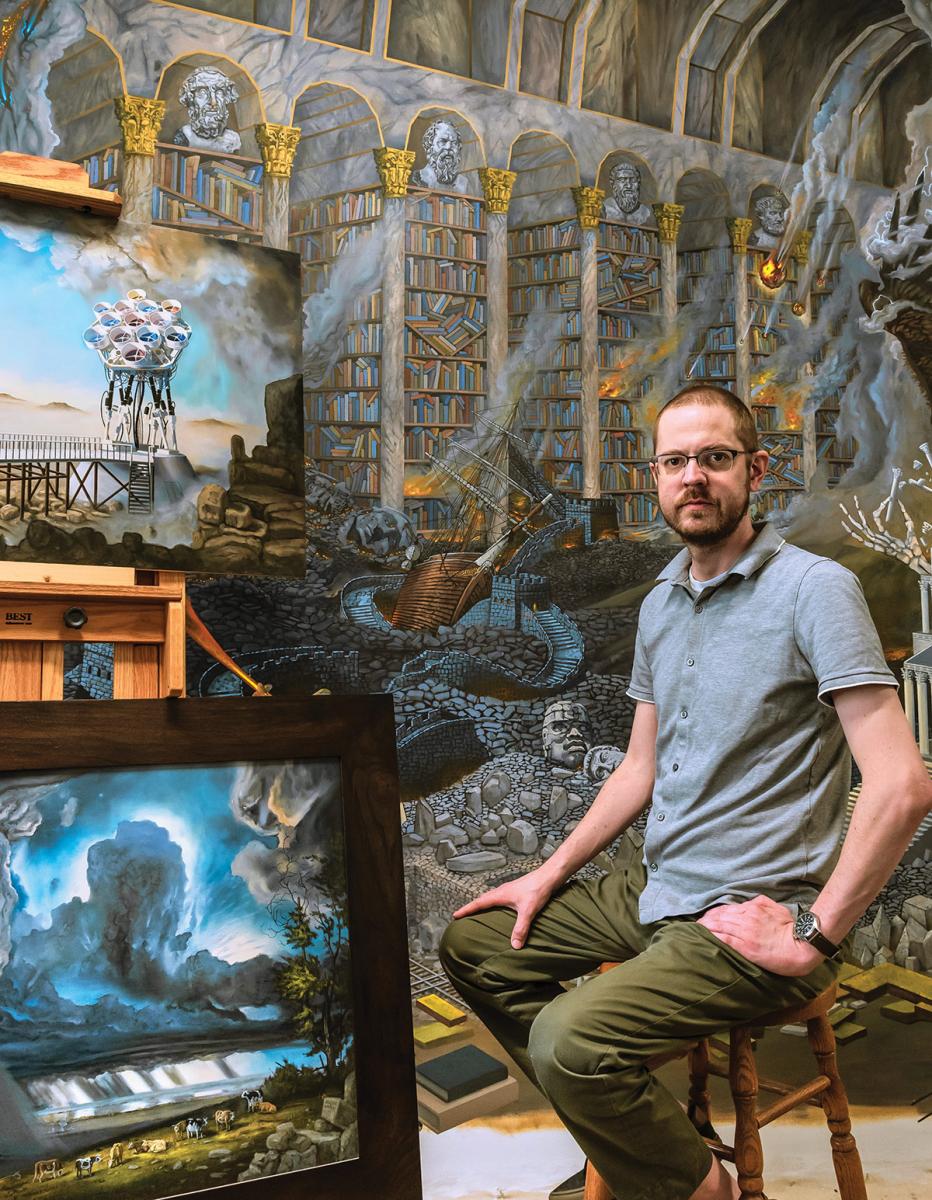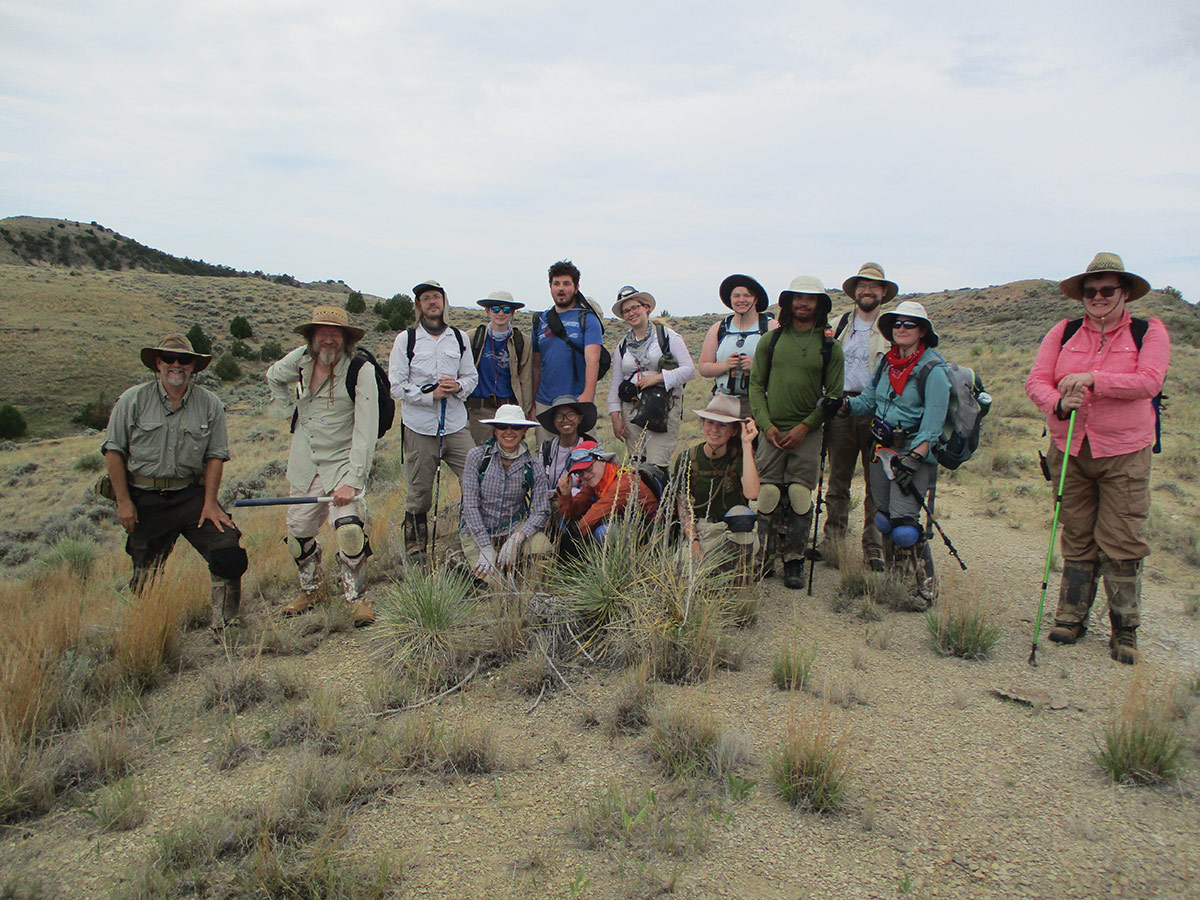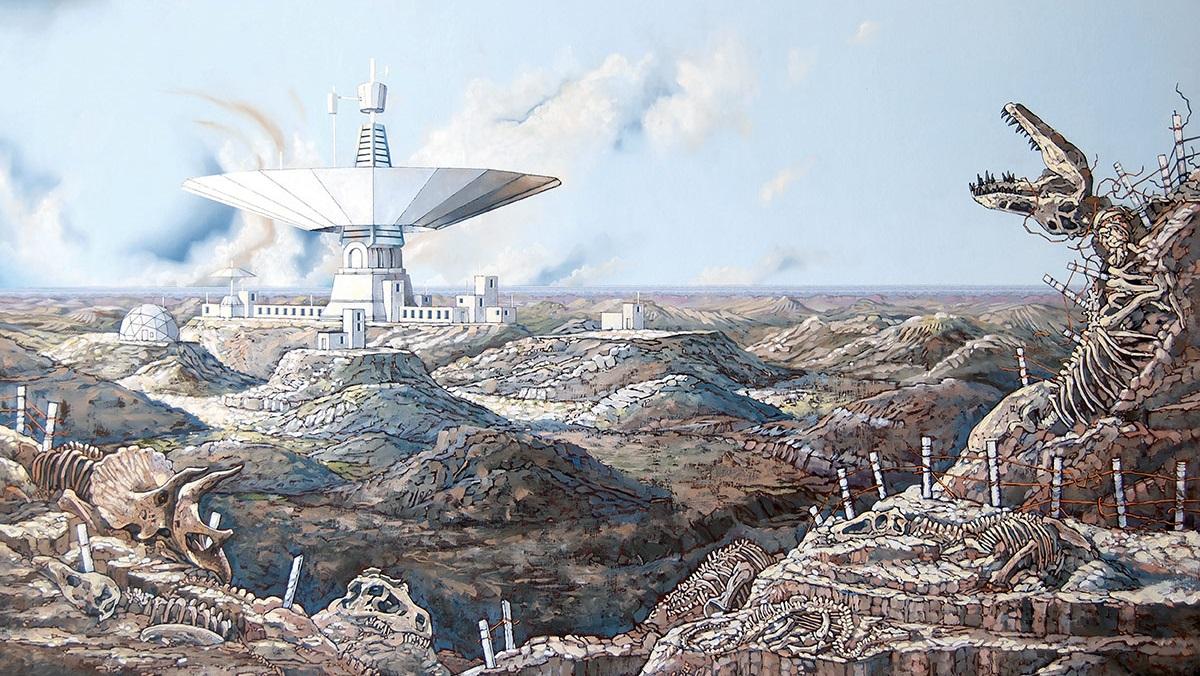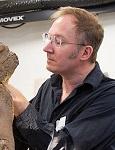The relationship between science and society is an important one and arguably a measure of the intellectual and aspirational health of our civilization. One way to keep this relationship strong is to encourage the participation of artists in the scientific enterprise. Carthage College’s Institute of Paleontology in Kenosha does just that, providing an opportunity for artists, from visual to literary, to join its annual field school expeditions to collect, prepare, and conserve fossils. The participation of artists in this work has had profound effects for all involved, as they explore questions of science and experiment with interpretations and ways of communicating the experience.
As a vertebrate paleontologist, I study the growth and evolution of Tyrannosaurus rex and its relatives and direct the Institute of Paleontology at Carthage College which trains undergraduate students in the science’s skills of research, fieldwork, and laboratory work. The program is supported by the College and by the City of Kenosha, which houses the College’s fossil preparation laboratory in the city’s Dinosaur Discovery Museum. The dinosaur fossils collected during the field season are stored there and are displayed in the museum’s public exhibits. Students and volunteer citizen-scientists, including artists, help us collect fossils each summer in southeastern Montana.
One of these artists, Matthew Warren Lee, is an American landscape painter from Milwaukee who works primarily in oils. He earned degrees in painting and drawing from the University of Wisconsin-Milwaukee, and is currently a professor at the Milwaukee Institute of Art and Design (MIAD). One thing that sets Matthew’s artistic work apart is that his subject matter is drawn from first-hand experiences as a participant-observer of field-based science. Matthew has worked as staff at a research facility in icy, hostile, and awe-inspiring Antarctica and as a citizen-scientist in dusty southeastern Montana.
While employed by a subsidiary of Raytheon, Matthew had two deployments in Antarctica. The first was in 2008, when he spent six months on the coast of the Transantarctic mountains as a member of the housekeeping staff at McMurdo Station.
Following a six-month break, Matthew began a second deployment as a porter at the Amundsen-Scott South Pole Station, where projects include the Ice Cube program to find neutrinos in the 9,000-foot thick ice sheet. During the continuous night of Antarctic winter, Matthew was the sole janitor in the station, which was the only shelter from the profound outside chill of -103 F. While at the South Pole Station, he visited the Geographic South Pole and witnessed the Aurora Australis overhead, which inspired several of his paintings.
Along with the crushing depths of oceanic trenches and the frigid, oxygen-deprived summits of the tallest mountains, Antarctica is the harshest environment on the planet. Matthew spent 371 days there, and his experiences are beautifully expressed in his paintings, which depict the starkness of the research station and its telescopes.

I met Matthew in 2015 when he joined our volunteer paleontology field program, five years after his Antarctica experiences. He had completed his master’s degree and was teaching art at the Milwaukee Institute of Art and Design. He stood out among the volunteers as especially hard-working, dedicated, and serious about our scientific mission. He became an integral member of the field crew, so teaming up with MIAD was a natural progression for us. The undergraduate field course is available to all students who have an interest in dinosaurs or paleontology, and for non-science students, our course might be their only opportunity to do field science. In 2018, Matthew selected 7 of his students to join the fieldwork. Each was expected to keep a daily illustrated diary of their work and their finds. Since then, he has participated in our field course as an instructor of students from MIAD.
During our summer program, we collect fossils from the badlands of Montana on public lands that are eroded out of the Hell Creek Formation (HCF). The Hell Creek Formation is a division of mostly Upper Cretaceous with some lower Paleocene rocks, named for exposures along Hell Creek, near Jordan, Montana. The formation stretches over portions of Montana, North Dakota, South Dakota, and Wyoming. This unit of rock was deposited during the last million years of the age of dinosaurs and contains fossils from the entire ecosystem, including plant fossils, the bones of fish, amphibians, lizards, crocodylians, and, of course, dinosaurs. These remains were buried by the ancient river system flowing east from the young Rocky Mountains and eventually fossilized underground before erosion brought them to the modern surface.
Each year, we apply to the Bureau of Land Management for two sets of permits: the first, to surface collect fossils that have eroded from the rocks and fallen onto the ground, and the second, to continue or start quarries—the large holes that we dig to retrieve the skeletons of massive dinosaurs, such as Triceratops. Our scientific goals are to document the changes in flora, fauna, and geology that were abruptly truncated by the great dinosaur extinction event. Those goals cannot be achieved without the help of a great number of people, and we rely on college students and volunteers from all walks of life, from pipefitters to landscape painters.
The Hell Creek Formation has a special scientific significance because it is the last layer of rock that was deposited in the American West before the mass extinction event that wiped out the non-avian (non-bird) dinosaurs, clearing the path for our own future. Our field area is unique in that it encompasses the boundary between the age of dinosaurs and the age of mammals. While prospecting for fossils, we often cross that existential line in a step. The HCF is where ends beget origins, and our field area is a place that inspires reflection and lends our work a deep purpose in the mission of the scientific enterprise.
Yet some of my best memories of summer fieldwork in the Hell Creek Formation are not of collecting fossils in the badlands, but of time spent inside the little house that we live in out there. After each excursion to the field, Matthew would sit at the long dining room table making detailed notes and sketches of fossils that he found that day. As a scientist, I find it is most rewarding to witness the magic of the creative process happening in front of me, evidence of Matthew’s deep level of commitment and engagement with our overall mission, the recovery of evidence of a lost world.
Paleontology and the HCF have become an important point of reference for Matthew’s art, as seen in his sketchbook and in paintings like Una Historia Una Veritas. What I see in Matthew’s art is humanity poised at an important and vulnerable moment in history. We are 300 years downstream from the Enlightenment, and despite the many scientific and technological advances made since then, the thought nags that the scientific endeavor may be fleeting. Time is vast, space is vast, the planet is vast, and so too is the probability of civilizational collapse. In the juxtaposition of landscape, fossils, technology, habitations, and the capricious sky, Matthew’s works capture the achievement, the vulnerability, and the potential ruin of our moment.
Our species is 230,000 years old, and only in the past 400 years, since Galileo, have we had the scientific method to help us understand our planet. Our current moment of paleontology, radio astronomy, and genomics was not inevitable, and given the vagaries of human behavior and a deteriorating planetary climate, it is not guaranteed to last. Matthew’s paintings capture the extremes that humanity is willing to suffer to hold this moment for all it is worth: telescopes built in the most extreme and dangerous places on Earth (The Diligent Truth, Rainspell, The Tempest) and fitted into crevices in cities. His art shows the window of scientific opportunity wide open and dazzling, but vulnerable to human fallibility and the power of Nature.
In terms of iconography, Matthew’s works emphasize verticality; whether it be a column in a classical ruin, a blazing tree, a radio telescope, a neutrino detector, or a mountain, the oppressiveness of the ground and sky are resisted by their reach. Matthew’s paintings emphasize that in our quest for knowledge we stretch upwards as far as we can reach, though we are gravitationally held to the Earth. Now that the James Webb Space Telescope has attained its million-mile distant orbit, the upward-facing instruments have a special poignance: the earth-bound telescopes point toward their aloft descendant in a harmonious reception of data.

Many of Matthew’s oil paintings are reminiscent of Albert Bierstadt, a popular landscape painter of the mid-1800s whose mountains were high and jagged and majestic and whose skies were striking. Other depict more bucolic scenes, calling to mind Frank Church, another leading painter of the Hudson River School of artists. In fact, Matthew has titled some of his works after these early painters. In many of these scenes, and in his more fantastical landscapes where geologic features take on large crystalline shapes, there sits the scientific instrument, alone or in an array, seeking more data, more knowledge. Because many of his paintings are fairly large he makes advance pencil sketches to get the correct perspective, particularly if a scientific array is featured. These perspective drawings themselves are beautiful works and reveal Matthew’s skill as a draftsman.
The scientific instruments that appear frequently in Matthew’s work—a dish-shaped radio telescope and a neutrino detector—are tools that have helped to uncover the fact that we live 13.8 billion years downstream of the Big Bang. They speak to the place of our civilization in the history of the Universe. Since the quantum origin event of the Universe, it has been expanding at an ever-faster pace. We live at a fortunate moment in the history of the Universe: our neighboring galaxies can still be observed. Scientists estimate that in a trillion years, our descendants (if we have descendants) will be unable to observe any other galaxies because the distance between them will be too great for the speed of light to overcome.

At the universal scale, radio telescopes on the ground can overcome today’s relatively short intergalactic distances. The radio telescopes and neutrino detectors in Matthew’s paintings are icons of the fulfilled promise of science: extending our reach to enhance our understanding. The instruments are often the focal point of his paintings, whereas the builders and users of the instrumentation are nowhere to be seen. Instead, the white and gleaming artifacts of scientific progress stand in for the facilitators of triumph—we can deduce their motivations, as searchers, from the corolla-like dishes alone.
In addition to overcoming intergalactic spatial distances, telescopes also overcome temporal distance. The electromagnetic radiation from galaxies that is received by telescopes has traveled in straight lines from stars to Earth at the speed of light, which means that it has taken time to reach us. The light from other stars and galaxies that we see at night is fossil light: a photon that arrived here today from a distant star may have started its journey 66 million years ago, coinciding with the extinction of the dinosaurs, but arriving now, given its distance from Earth.
When we use telescopes to view the night sky, everywhere we look, we see into the past. In Matthew’s work, the radio telescope and neutrino detector are emblems of civilization’s triumph in our quest to understand the Universe, our place and time in it, and our ability to use physics and technology to overcome the long isolation from the rest of the Universe imposed by space and time. Juxtaposed with fossils, radio astronomy and paleontology are revealed as parallel projects.

There is often an interesting disconnect between an artist’s intention and the audience’s interpretation of a work. Take Matthew’s painting, Una Historia Una Veritas, in which I see a statement on the impermanence of the scientific moment. However, Matthew has written that the painting “reimagines Montana as a scientific utopia, covered in immaculate specimens with a massive telescope holding vigil over the tableau.” Perhaps an important role of art is to inspire new trains of thought, no matter how different from the artist’s intent.
The painting is a striking one for me, since complete immaculate specimens are the exception, not the rule. In a sun-addled frame of mind after several hours of fruitless prospecting, I am desperate to find even one identifiable scrap of bone or a tooth. So, at the most basic level, the painting represents the most optimistic end of the spectrum of fieldwork. Last summer Matthew and I shared the experience of approaching that end of the spectrum when we prospected an area that we had never before explored.
The American West is divided into a checkerboard of roughly one square mile sections of land. Some sections are private land owned by ranchers, and others are public lands leased to ranchers for livestock or agriculture. Public lands are managed by the Bureau of Land Management. The public lands to which we are permitted access is extensive, and there are a number of sections we’ve been unable to visit simply because we are still busy collecting at sites where we’ve been for years.
Last year we decided to venture to new and distant sections of public land. Matthew was part of the first team to explore the first section, and within a couple of hours, he found three Triceratops skeletons weathering out of the hills. Usually, in the more thoroughly picked-over sections we’d been working, we would find perhaps one new Triceratops locality in a four-week field season. A day or two later, I found three more Triceratops localities to the west of Matthew’s find. One of our standard practices is to let our field participants name the new fossil localities they find, which brings us to another of Matthew’s interests, mathematics.

Mathematics, the pure language of science, is an interest that appears in Matthew’s series of engineering drawings that include meticulous diagrams of involutes and thrackles (a type of graph in which points must touch in a particular way). He named his Triceratops localities after notable mathematicians: “Conway’s Thrackle” for English mathematician John Horton Conway’s thrackle conjecture; “Ramanujan’s Taxi” for an amusing anecdote about Indian mathematician Srinivasa Ramanujan’s insights into a taxicab number; and Mirzakhani’s Torus for Iranian mathematician Maryam Mirzakhani, who studied the geometric and dynamic complexities of curved surfaces.
Matthew’s interest in mathematical structures includes the Golden Spiral, which is featured subliminally in paintings like Una Historia Una Veritas and The Ancient Cluster, and is fully rendered in his preparatory drawings. Spirals occur spontaneously in nature: in the arms of spiral galaxies, the coils of a nautilus shell, ripples in a vortex, and in clusters of leaves and petals. In Matthew’s works, the spiral becomes a means for Nature to know itself, mediated by human consciousness, however brief that may be.
I formulated the motto Una historia, una veritas (one history, one truth) as a graduate student, and it is has since become the motto of the Carthage Institute of Paleontology. It neatly summarizes the CIP’s alignment with the overall project of Science: to recover the single history of Earth and, by extension, its place in the history of the solar system, the Milky Way galaxy, and the Universe. The motto is a logical extension of the scientific method, which holds that the Universe is knowable by systematic observation and hypothesis testing. All available evidence tells us that the Universe has a single, knowable history. Science is a truly unique intellectual endeavor, one that seeks to undermine its own knowledge claims with skepticism and experiment. It is that rigorous process of self-testing that has allowed us to sort fact from fiction, to advance from mere stargazing to the sophisticated Sloan sky survey (a three-dimensional map of the universe) in only a few centuries. I am gratified that Matthew has used this motto as the title for one of his paintings.
Matthew Warren Lee is a scientist’s artist—he combines mathematics, geology, osteology, landscape, technology, and sky in his art in a way that is consistent with the goals and challenges of science. In his paintings, science and art are working together to recover the origins of all things, and there is no boundary between humanity and our evolutionary history. His art is a companion to the science, showing that this human endeavor is itself a product of Nature, with all of the attendant risks of environment, climate change, motivation, conflict, and time. His work illustrates what is possible when artists participate in the scientific enterprise, and how that participation benefits our civilization.




